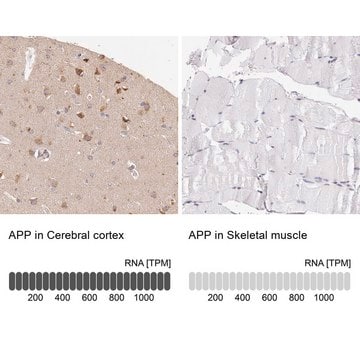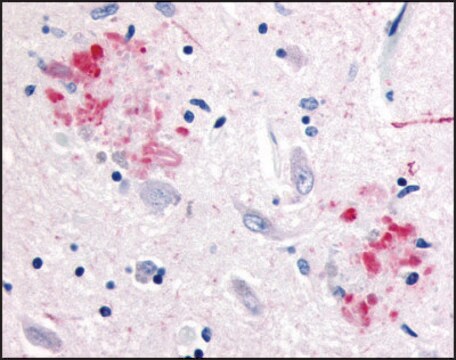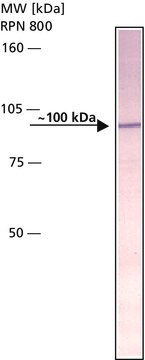MAB343
Anti-Amyloid Precursor Protein (APP) Antibody
CHEMICON®, mouse monoclonal, 2.F2.19B4
Sinonimo/i:
APP, Jonas clone
Scegli un formato
759,00 €
Spedizione prevista il18 aprile 2025Dettagli
Scegli un formato
About This Item
759,00 €
Spedizione prevista il18 aprile 2025Dettagli
Prodotti consigliati
Nome del prodotto
Anti-APP Antibody, APP 643-695 CT fragment, clone 2.F2.19B4, ascites fluid, clone 2.F2.19B4, Chemicon®
Origine biologica
mouse
Livello qualitativo
Forma dell’anticorpo
ascites fluid
Clone
2.F2.19B4, monoclonal
Reattività contro le specie
rat, human
Produttore/marchio commerciale
Chemicon®
tecniche
immunohistochemistry: suitable (paraffin)
western blot: suitable
Isotipo
IgG1
N° accesso NCBI
N° accesso UniProt
Condizioni di spedizione
dry ice
modifica post-traduzionali bersaglio
unmodified
Informazioni sul gene
human ... APP(351)
Specificità
Immunogeno
Applicazioni
Western blot: 10 μg/mL
Optimal working dilutions must be determined by end user.
APPLICATION NOTES FOR MAB343
IMMUNOHISTOCHEMISTRY
1) Prepare paraformaldehyde-fixed paraffin sections. Wash twice for 5 min in xylene to deparaffinize. Wash sections for 5 min in a descending series of alcohol solutions (100%, 96%, 90%, 80%, 70%, 50%, 30%).
2) Wash sections 3 times in distilled water.
3) Wash in TBS (50 mM Tris-HCl, 150 mM NaCl, pH 7.6). To block endogenous peroxidase wash with methanol containing 0.6% H2O2 (v/v) and 10 % horse serum (v/v) for 5 min at room temperature.
4) Wash sections for 5 min in TBS.
5) Incubate sections with MAB343 (diluted in TBS containing 10% horse serum (v/v)) overnight at +4°C or for 2 hours at 37°C in a humid chamber.
6) Wash sections 3 times in TBS for 5 min..
7) Detect with standard secondary antibody detection system (PAP, ABC, etc.).
8) Wash sections in TBS.
9) Embed sections and examine.
Neuroscience
Neurodegenerative Diseases
Stato fisico
Stoccaggio e stabilità
Risultati analitici
Brain
Altre note
Note legali
Esclusione di responsabilità
Raccomandato
Codice della classe di stoccaggio
10 - Combustible liquids
Classe di pericolosità dell'acqua (WGK)
WGK 1
Punto d’infiammabilità (°F)
Not applicable
Punto d’infiammabilità (°C)
Not applicable
Certificati d'analisi (COA)
Cerca il Certificati d'analisi (COA) digitando il numero di lotto/batch corrispondente. I numeri di lotto o di batch sono stampati sull'etichetta dei prodotti dopo la parola ‘Lotto’ o ‘Batch’.
Possiedi già questo prodotto?
I documenti relativi ai prodotti acquistati recentemente sono disponibili nell’Archivio dei documenti.
Filtri attivi
Il team dei nostri ricercatori vanta grande esperienza in tutte le aree della ricerca quali Life Science, scienza dei materiali, sintesi chimica, cromatografia, discipline analitiche, ecc..
Contatta l'Assistenza Tecnica.








